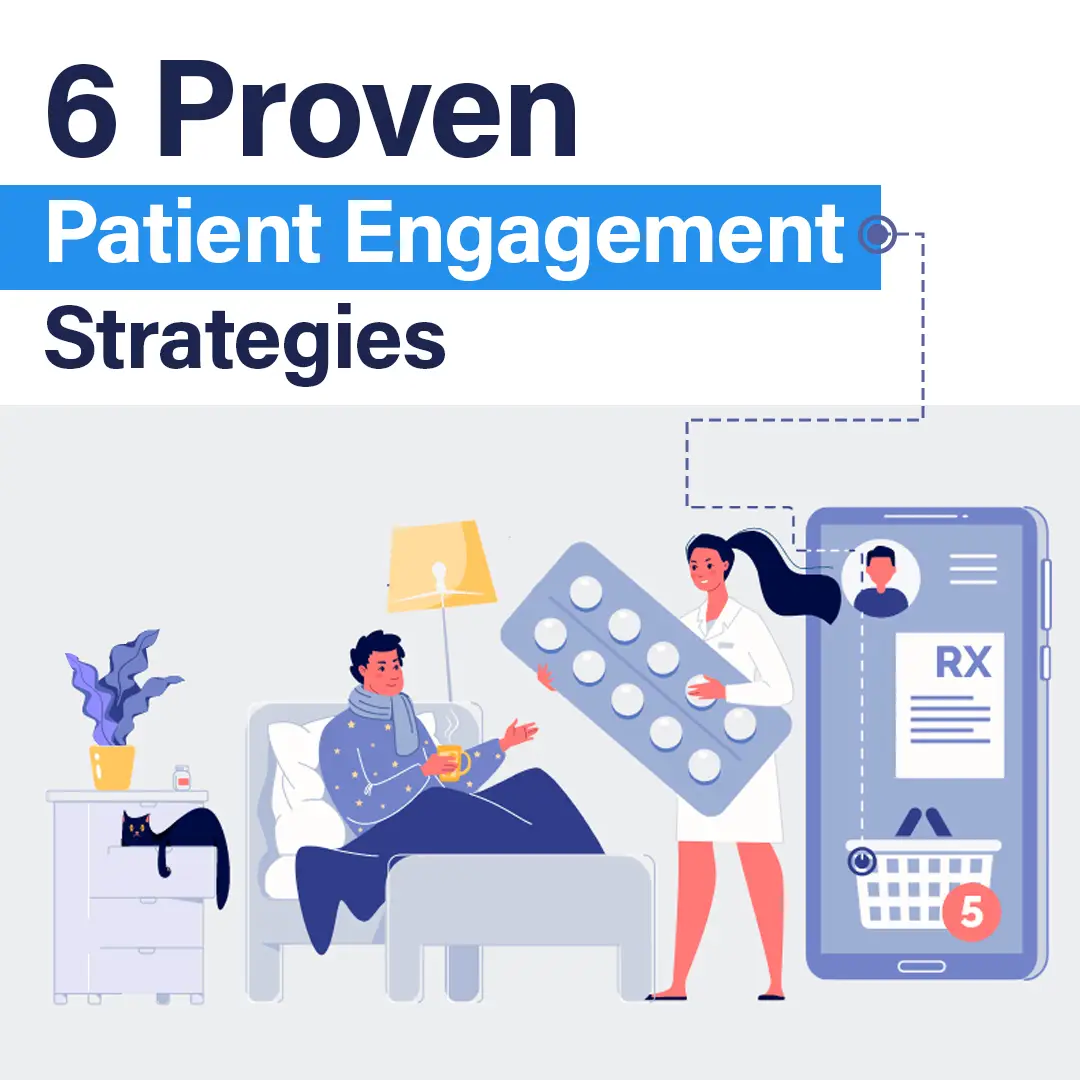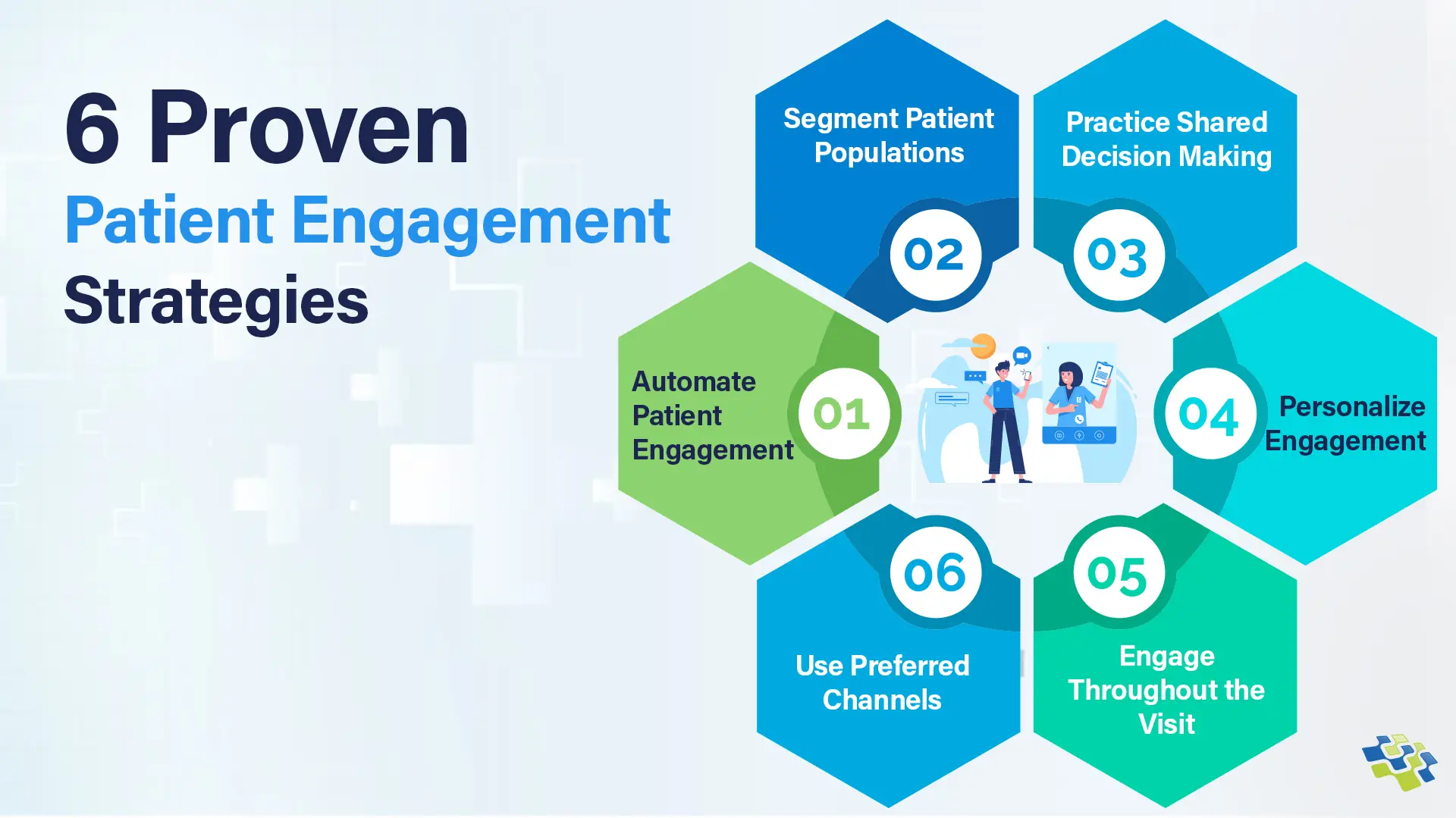6 Proven Patient Engagement Strategies
This shift represents a pivotal change, emphasizing the fundamental role patient engagement strategies play in shaping the future of healthcare.

“Research shows that 50% of chronic patients miss doses or discontinue treatment, causing 125,000 U.S. deaths yearly and $290B in extra costs. Patient engagement, boosting medication adherence by 60%, reduces issues and hospitalizations significantly, enhancing overall healthcare outcomes and efficiency.”- Mckinsey
Overview of Patient Engagement in Healthcare
Patient education on available medical treatments, recovery alternatives, and prescriptions to improve outcomes is a key component of patient engagement in healthcare. Healthcare providers strive to engage patients effectively, ensuring accessibility during emergencies and promoting self-care. Informed patients comprehend their health issues, symptoms, medications, and dietary restrictions, enabling proactive self-management. Studies show that well-informed patients exhibit a 30% increase in treatment adherence, underlining the significant impact of patient engagement on healthcare outcomes. Accessible and informative patient interaction platforms are fundamental for healthcare organizations, forming the cornerstone of patient welfare initiatives. These platforms facilitate informed decision-making, fostering a collaborative healthcare environment that prioritizes patient knowledge and empowerment for improved overall health results.
Benefits of Patient Engagement Apps
Technology has significantly enhanced patient engagement in healthcare. Utilizing innovative tools like IoT devices and AI-powered solutions, healthcare organizations can remotely communicate with patients, collect vital medical data, and transmit it to doctors. Patient participation platforms reduce costs and improve health outcomes. These advancements foster efficient communication, leading to better healthcare results and patient experiences.
- Simplify the Patient Engagement Process: Personalized engagement platforms streamline patient experience by scheduling medical appointments, sending clinic visit reminders, and monitoring health vitals. These platforms also provide valuable insights into patients’ medical histories, aiding treatment strategies. Patients can access information about activities, diets, and healing processes, enhancing their overall healthcare journey.
- Understanding Patient Behavior: Healthcare organizations use smart platforms to connect with patients. Through software development services, these platforms analyze patient behaviors, enabling customized treatment plans and ongoing support, and enhancing patient-provider communication.
- Employing the Risk Assessment Strategies: A patient engagement platform assesses potential risks for patients, relying on crucial medical data. It utilizes patient behavior and medical history to offer optimal treatment options and forecasts healthcare needs. This platform serves as a foundation for informed decision-making, enabling personalized and effective patient care.
- 24*7 Communication Via Chatbots: Traditional waiting in line or on hold for answers is outdated. AI-powered chatbots in patient engagement platforms ensure rapid, accurate connections, filtering, and tailoring responses 24/7.
Further Read: How Digital Transformation Fuels Healthcare Innovation?
6 Proven Patient Engagement Strategies
Implement these 6 patient engagement strategies to optimize healthcare outcomes. By fostering active patient engagement and tailored communication, these methods enhance satisfaction, treatment adherence, and overall well-being, ensuring a patient-centered approach for improved healthcare results.
 1. Automate Patient Engagement
1. Automate Patient Engagement
Leveraging technology is pivotal for efficient healthcare, and automation stands at its forefront. Automated solutions streamline interactions, optimizing patient follow-ups and enhancing workforce productivity. Despite initial concerns about the loss of human touch, automated tools have proven indispensable, especially during crises like the COVID-19 pandemic. Research underscores their impact, revealing a remarkable 35% increase in patient satisfaction with the utilization of automated engagement tools. Automating interactions not only ensures effective communication but also significantly boosts patient happiness while mitigating staff burnout. By alleviating routine tasks, healthcare professionals can redirect their focus towards critical responsibilities, preventing staff shortages and maintaining high-quality patient care. These automated tools serve as a bridge, efficiently addressing patient needs while accommodating the limitations of healthcare provider capacities. Embracing automated patient engagement tools has become essential in modern healthcare, enabling a seamless balance between patient-centered care, staff well-being, and the demands of a rapidly evolving healthcare landscape.
2. Segment Patient Populations
Effective patient engagement requires personalization tailored to individual preferences and needs. Segmentation based on demographics, psychographics, and Social Determinants of Health (SDoH) is crucial. Studies show that personalized patient engagement strategies increase patient satisfaction by 40%. By comprehensively understanding patients’ unique attributes, healthcare providers can deliver interactions that are not only relevant but also impactful. Personalized approaches ensure that engagement efforts resonate effectively with diverse patient groups, optimizing the impact of healthcare interventions. Considering these variables is essential in crafting meaningful and customized patient experiences, a crucial factor in driving improved healthcare outcomes. Through such tailored strategies, healthcare providers can foster deeper connections with patients, enhance adherence to treatment plans, and ultimately, create a healthcare environment rooted in patient-centricity and successful outcomes.
3. Practice Shared Decision Making
Shared decision-making represents a transformative shift in healthcare, deviating from traditional norms to enhance patient engagement and reduce unnecessary hospitalizations, leading to improved outcomes. Historically, patients were passive recipients of care, lacking input in their treatment decisions. However, this paradigm has evolved, empowering patients and clinicians to collaborate closely on treatment plans. There is a substantial 20% reduction in hospital admissions when patients actively participate in shared decision-making processes. Although this approach requires additional time for patient education, encouraging patients to take an active role in their healthcare significantly boosts satisfaction and engagement levels. Recognizing patient preferences, especially among specific psychographic segments, is pivotal. Tailoring the degree of shared decision-making ensures a patient-centered approach, aligning treatment choices with individual needs and preferences. This personalized strategy fosters effective healthcare engagement, building trust and rapport between patients and providers. Embracing shared decision-making not only empowers patients in their healthcare journey but also contributes significantly to better health outcomes and a more satisfying patient experience.
4. Personalize Engagement
Segmenting patients is a pivotal patient engagement strategy in healthcare, tailoring interactions for personalized care. By categorizing patients based on factors like age, gender, medical history, diagnosis, and insurance, communication becomes targeted and relevant. For example, providing mammography information to women or sharing diet studies with diabetics enhances engagement significantly. There is a 25% increase in engagement rates with targeted segmentation. When healthcare messages resonate with specific patient needs, they become more meaningful, amplifying their effectiveness. This customized strategy not only increases patient participation but also fosters a closer relationship between patients and healthcare professionals. It fosters a sense of trust and understanding, vital for successful healthcare relationships. Recognizing patient diversity and addressing their unique concerns ensures a more individualized and efficient healthcare experience. Moreover, this approach is essential for enhancing treatment adherence and overall patient satisfaction. In the dynamic landscape of healthcare, patient segmentation stands as a fundamental practice, elevating the quality of care, strengthening patient-provider relationships, and improving health outcomes.
Listen Strategies for Patient Engagement
5. Engage Throughout the Visit
Active patient engagement throughout the entire healthcare process is indispensable for optimal outcomes. Educating patients pre-, during, and post-treatment is fundamental. As per recent studies, there is a 40% lower risk of hospital readmission, emphasizing the impact of engagement. Healthcare providers must ensure patients comprehend diagnoses, treatments, and necessary lifestyle changes. Involving patients in decision-making empowers them, making them active participants in their care plans. Furthermore, the post-treatment phase is equally crucial. Continuous support and guidance after discharge are essential to adherence to aftercare guidelines. Patients who receive consistent support during the aftercare period are more likely to follow their prescribed treatments, reducing the chances of complications and readmissions. Beyond medical aspects, emotional and informational support is vital. Regular communication highlights genuine concern, fostering trust and understanding. This trust significantly impacts patients’ overall well-being and satisfaction. Active engagement enhances patient autonomy, enabling them to manage their health effectively. Additionally, technology plays a crucial role in patient engagement. Telemedicine, mobile apps, and online platforms facilitate continuous communication and provide resources for patients to access information and support remotely. Comprehensive patient engagement involves education, involvement, ongoing support, and leveraging technology.
6. Use Preferred Channels
Incorporating the patient engagement approach involves segmenting patients based on their preferred communication methods. For example, older patients may prefer traditional phone calls, while younger individuals may prefer WhatsApp or email. It is crucial to identify patients’ comfort zones and provide support through these channels. By tailoring communication to their preferences, successful engagement and interaction are significantly enhanced. Choosing the right communication channel ensures effective patient-provider communication, fostering a more personalized and comfortable experience for patients. This approach acknowledges diverse communication needs, promoting a patient-centered environment where individuals are engaged through channels, they find convenient and familiar. Ultimately, this tailored approach optimizes patient satisfaction, improves adherence to medical advice, and strengthens the overall healthcare experience by facilitating seamless and preferred communication between patients and healthcare providers.
Further Read: Adoption of Generative AI in Healthcare & Life Sciences
How can Patient Engagement Apps provide ROI?
Evaluating the value of a patient engagement solution involves assessing specific Key Performance Indicators (KPIs). These metrics include patient no-show rates, appointment availability, total appointment volume, patient payments, wait times, portal utilization, and ease of compliance with initiatives like PCMH and MIPS reporting. By tracking these KPIs, healthcare providers can measure the effectiveness of patient engagement apps and their return on investment (ROI). Lower no-show rates indicate improved patient attendance, while efficient appointment scheduling and reduced wait times enhance patient satisfaction. Streamlined payment processes and increased portal usage signify enhanced operational efficiency. Additionally, seamless compliance with reporting initiatives indicates the solution’s effectiveness in meeting regulatory requirements. Analyzing these KPIs provides valuable insights into the app’s impact, helping healthcare providers make data-driven decisions to optimize patient engagement strategies and maximize the app’s ROI.
Conclusion
Patient engagement in healthcare has rapidly become paramount, with patients taking charge of medical decisions and demanding digital access. Effective patient engagement strategies leverage well-developed apps that integrate third-party interfaces, cover various touchpoints, and ensure scalability, security, and regulatory compliance. At NextGen Invent, we understand the crucial role of patient engagement. Our innovative, scalable, and accessible solutions empower medical practitioners to enhance patient interactions, ensuring a seamless healthcare experience.
Elevate your healthcare practice with our software development services. Discover innovative patient engagement solutions tailored to your needs. Contact us to revolutionize your patient interactions and enhance healthcare outcomes.
Stay In the Know
Get Latest updates and industry insights every month.
 1. Automate Patient Engagement
1. Automate Patient Engagement